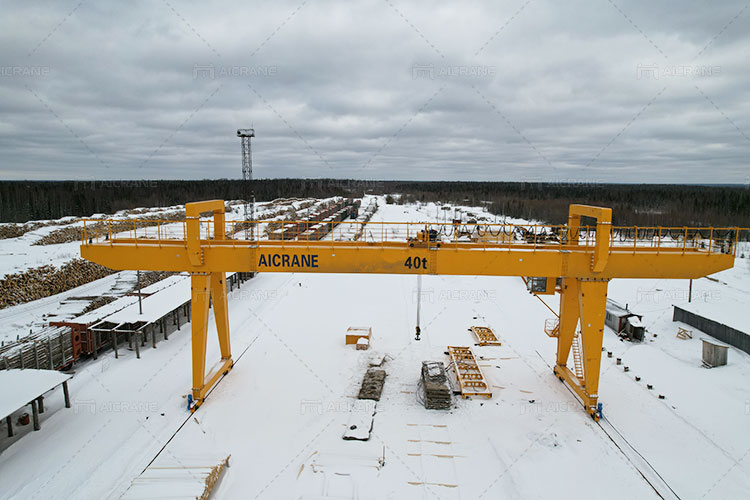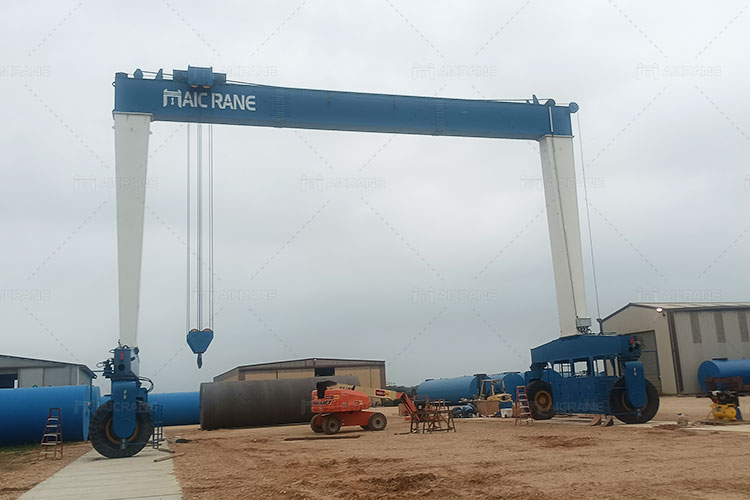In the field of heavy lifting and material handling, 40-ton gantry cranes are essential equipment used in industries such as construction, manufacturing, shipbuilding, precast concrete, and steel processing. These cranes are known for their ability to lift and transport heavy loads with efficiency and safety. As customer requirements evolve and project complexity increases, modular design has emerged as a highly advantageous approach in the engineering and manufacturing of 40-ton gantry cranes.
Modular design refers to an engineering strategy in which a system is composed of separate, interchangeable components or modules that can be independently designed, manufactured, replaced, and customized. In gantry crane systems, modularity significantly improves production flexibility, reduces lead time, and enhances scalability, adaptability, and maintainability.
In this article, we will explore the key benefits of modular design in 40 ton gantry cranes and how it contributes to cost-efficiency, operational effectiveness, and future-proofing.

1. Ease of Customization and Scalability
One of the primary benefits of modular design in 40-ton gantry cranes is its ability to accommodate customized configurations without requiring a complete redesign. Different projects may require specific lifting heights, spans, cantilever lengths, or environmental protection standards. With modular design, engineers can easily select or adjust the appropriate modules—such as gantry legs, cross beams, hoist mechanisms, control systems, and trolley configurations—based on project requirements.
This flexibility is particularly valuable when designing cranes for diverse applications like:
-
Lifting precast concrete elements in construction sites
-
Handling steel coils in industrial yards
-
Operating in outdoor marine or shipyard environments
-
Working in high-altitude or temperature-sensitive areas
With standardized modules, the 40t double girder gantry crane can be scaled up or down more efficiently to suit load demands, terrain conditions, or operational requirements.
2. Faster Manufacturing and Shorter Lead Times
Modular systems allow manufacturers to streamline the production process by using pre-engineered and pre-manufactured components. These components are often stocked or readily available, meaning that a significant portion of the crane can be built without delay.
This leads to:
-
Faster assembly times in the factory
-
Reduced engineering design time
-
Quicker adaptation to urgent customer requirements
In today’s competitive industrial environment, reducing the time from order to delivery is a strong selling point. Customers needing a 40-ton gantry crane for a time-sensitive infrastructure or port handling project can benefit significantly from this advantage.

3. Simplified Transportation and On-Site Assembly
Transporting a large-capacity rail gantry crane to a job site, especially one with a long span or high lifting height, can be logistically challenging and costly. Modular design solves this problem by breaking the crane into smaller, transportable modules that can be shipped using standard containers or flatbeds.
Once on-site, these modules can be quickly assembled using bolt connections and standardized interfaces. This means:
-
Lower transportation costs
-
Faster on-site installation
-
Reduced need for specialized lifting or assembly equipment
For remote or hard-to-reach project locations—such as mountain tunnel entrances, river ports, or infrastructure development zones—this ease of delivery and setup is critical.
4. Maintenance and Repair Efficiency
Another core advantage of modular gantry crane design is the simplification of maintenance and repairs. Since the crane is composed of standardized, independently functioning modules, identifying, accessing, and replacing faulty parts becomes much easier.
For example:
-
A damaged trolley module can be replaced without dismantling the entire crane
-
Wear and tear on the hoisting mechanism can be addressed independently
-
Electrical modules or control panels can be updated without affecting the mechanical systems
This plug-and-play functionality minimizes downtime and improves operational uptime, especially in industrial facilities with continuous operation demands.
5. Easier Upgrades and Technology Integration
Modular gantry cranes can be designed with future upgrades in mind. As new technologies emerge—such as smart load monitoring systems, remote diagnostics, AI-based control algorithms, and anti-collision systems—modules can be added or swapped without major reconfiguration.
This future-proofs the investment and allows customers to:
-
Start with a basic system and scale it up over time
-
Upgrade to more advanced safety systems
-
Implement wireless controls or automation modules
For example, a customer may initially use manual controls but later transition to fully automated operations with GPS-based crane positioning. Modular design supports these progressive changes without forcing the client to purchase a completely new system.
6. Cost-Efficiency Over the Life Cycle
Although initial investment may be slightly higher in modular systems due to the precision and standardization required, the overall life cycle cost of gantry crane is significantly lower. This is achieved through:
-
Lower maintenance costs
-
Reduced downtime and repairs
-
Easier part replacement
-
Better resale value due to flexible reconfiguration
Furthermore, because modules are often used across multiple crane models or capacities, manufacturers can benefit from economies of scale, reducing the long-term cost of components and spares.
7. Enhanced Safety and Compliance
Safety is a top priority in 40-ton crane operations. Modular designs allow for rigorous testing of individual modules before they are assembled into the complete crane system. This ensures that each module meets safety, structural, and performance standards.
Compliance with international standards (such as ISO, FEM, and DIN) is also easier to achieve because standardized modules can be certified in advance. This reduces the risk of compliance issues during final inspection or commissioning.
8. Global Support and Interchangeable Parts
For customers operating across different countries or with multinational operations, modular gantry cranes offer the advantage of consistent design and interchangeable parts. A spare part or module used in one country can be sourced or replaced in another, simplifying logistics and after-sales support.
Manufacturers can maintain a global inventory of standardized modules, offering faster customer service and reducing machine downtime worldwide.
Conclusion
Modular design in 40-ton gantry cranes is transforming how lifting systems are engineered, manufactured, and operated. From easier customization and rapid deployment to simplified maintenance and long-term cost savings, modularity addresses key challenges in the heavy lifting sector.
As industries seek greater flexibility, faster turnaround, and smarter integration, modular gantry cranes provide a practical and forward-looking solution. Whether in steel fabrication yards, power plant construction, or port operations, the modular approach enables cranes to perform efficiently today while adapting to the demands of tomorrow.